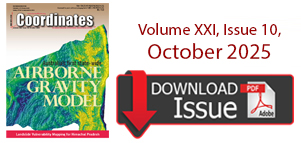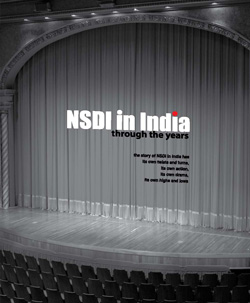Articles in the News Archives Category
Galileo to be scaled down?
The Financial Times claims the EU may be forced to operate the Galileo constellation with fewer than the currently proposed 30 satellites. The FT quotes Philippe Busquin, a former European research commissioner who now oversees the Galileo project as a member of the European Parliament as saying: ‘It’s not clear that we really need 30 satellites. We could certainly make Galileo a success with 24 or 25.’ Jack Metthey, a director handling research in the European Commission, also describes the Galileo budget situation as ‘very, very tight’, adding: ‘Having less satellites would certainly help address the money issue.’’ However, it is acknowledged that a reduction in the number of satellites could undermine the quality of the system, by reducing coverage and precision, two of Galileo’s trump cards as a 21st- Century constellation. www.rin.org.uk
An attempt is being made by volunteers all over the world to visit the confl uence points and document the scenery with pictures and narratives
Europe and Russia to restart talks on Galileo and Glonass operations
Negotiations on interoperability between the European Galileo and Russian Glonass satellite navigation systems are expected to restart soon, after a yearlong hiatus. The hope of talks follows an agreement on dialogue structures between the European Commission and Russia’s Federal Space Agency (FSA).
A trilateral steering board has been created for discussions between the EC, European Space Agency and the FSA. ESA already has working groups covering areas of co-operation under its framework agreement with the FSA, including satellite communications, global navigation and technology. These will include EC representatives and will report to the new steering board. A new working group on Earth observation will also be created.
www.flightglobal.com
Forest cover in Philippines on the rise
The Department of Environment and Natural Resources (DENR) revealed recently that satellite imagery and remote sensors indicate that the forest cover in Central Luzon has increased to 7.2 million hectares from 6.5 million hectares in 1988. www.manilastandardtoday.com
Border inspection mapping operation
China and Nepal will jointly launch a border inspection mapping operation. Both countries will apply GPS to survey the border marks. The major mapping work will be done by Chinese workers and then workers from Nepal will check the mapping data and results. The Surveying and Mapping Bureau of Shaanxi, from northwest China, has been appointed to take the task and will form the main body of the China team. The first batch of mapping workers are scheduled to arrive in the China-Nepal border area next month and all the outdoor surveying is planned to finish by the end of September. It is expected that the final mapping outcome will be unveiled by the end of 2007. www.vnagency.com.vn
GLONASS for civilian use in 2006
The restrictions on precise satellite definition of on-land coordinates will be lifted by yearend, a senior military official said. Lieutenant-General Valery Filatov said the location of geographical objects at accuracy of up to 30 meters would be available for civilian use from the Russian GLONASS satellite system and the US GPS.
www.spacedaily.com
Chunghwa Telecom and SiRF to offer A-GPS services
Chunghwa Telecom in Taiwan announced the formation of an alliance with SiRF International to establish an A-GPS platform for operation of mobile location services in the Taiwan market. CHT has finished R&D and testing of the A-GPS platform that integrates GPS technology with CHT’s mobile communication infrastructure, It initially offered A-GPS services to Taiwan SECOM, one of the largest provider of security services in Taiwan, at the end of last year and plans to offer personal A-GPS value-added services to mobile communication users later this year.
www.digitimes.com
New Tiny Surface Mount GPS Receiver
Trimble has introduced its new Copernicus GPS receiver – a thumbnail-sized, surface-mount, low power module ideal for adding GPS capabilities to Bluetooth appliances, sport accessories, personal navigators or cameras, computer and communication peripherals as well as vehicle tracking, navigation, and security products.
It enables system integrators to easily add GPS capability to a mobile device with minimal impact on its size or battery life at a very economical price.
www.trimble.com
GIOVE A Transmits Loud And Clear
After launch and platform commissioning, GIOVE A started signal transmission on 12 January and the quality of these signals is now being checked. This checking process is employing several facilities, including the Navigation Laboratory at ESA’s European Space Research and Technology Centre (ESTEC), in the Netherlands, the ESA ground station at Redu, in Belgium, and the Rutherford Appleton Laboratory (RAL) Chilbolton Observatory in the United Kingdom.
Chilbolton’s 25 metre antenna makes it possible to acquire the signals from GIOVE A and verify they conform to the Galileo system’s design specifi cation. Each time the satellite is visible from Chilbolton, the large antenna is activated and tracks the satellite. GIOVE A orbits at an altitude of 23 260 kilometres, making a complete journey around the Earth in 14 hours and 22 minutes.
The GIOVE A mission also represents an opportunity for the testing of a key element of the future Galileo system, the user receivers. The first Galileo experimental receivers, manufactured by Septentrio of Belgium, were installed at the Redu and Chilbolton In Orbit Test Stations and at the Guildford, United Kingdom, premises of Surrey Satellite Technology Limited (SSTL), the manufacturer of the satellite and now in charge of its control in orbit.
PCI Geomatics supports CARTOSAT-1 satellite data
PCI Geomatics announced that it has entered into a memorandum of understanding with Antrix Corporation Ltd. to develop an interface that integrates CARTOSAT-1 satellite data products in Geomatica, PCI Geomatics image-centric geospatial software. Antrix, a corporate arm of the Indian Space Research Organization (ISRO), launched the CARTOSAT-1 satellite on May 5, 2005, to provide stereo data for advanced and large scale mapping applications.
www.pcigeomatics.com
Multimap Australasia announces online mapping deal Multimap, one of the online mapping providers, announced the implementation of its online mapping services for the Commonwealth Travel Services Corporation (CTC), at the Travel Distribution Summit in Singapore (14th & 15th February, 2006). Now, customers of one of the largest and most trusted travel and tour operators in Singapore can access content-rich, easy-to-read interactive maps of their…











 (5.00 out of 5)
(5.00 out of 5)